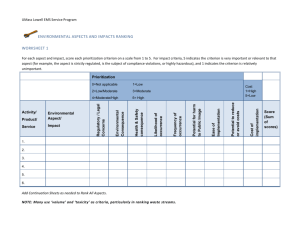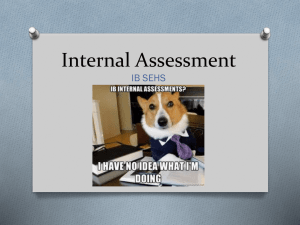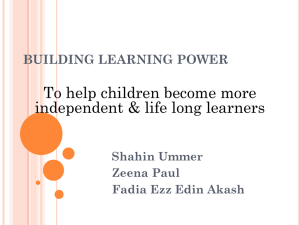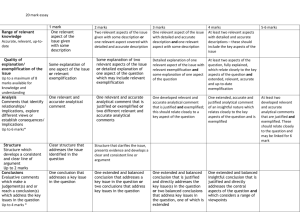File - AICE Psychology
advertisement
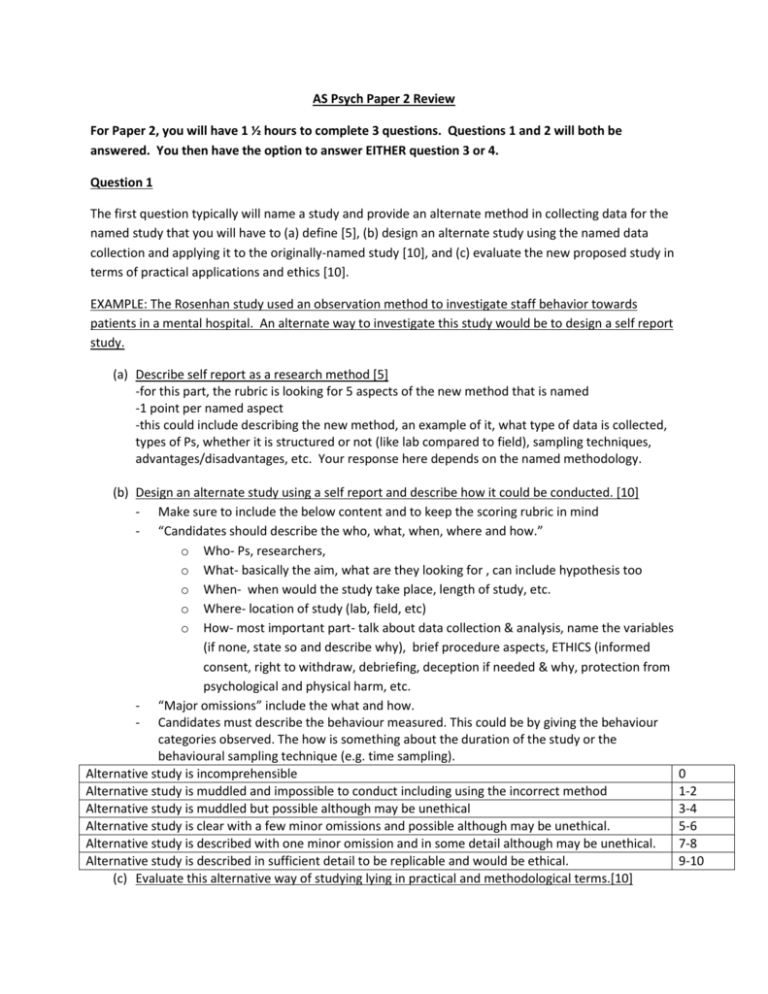
AS Psych Paper 2 Review For Paper 2, you will have 1 ½ hours to complete 3 questions. Questions 1 and 2 will both be answered. You then have the option to answer EITHER question 3 or 4. Question 1 The first question typically will name a study and provide an alternate method in collecting data for the named study that you will have to (a) define [5], (b) design an alternate study using the named data collection and applying it to the originally-named study [10], and (c) evaluate the new proposed study in terms of practical applications and ethics [10]. EXAMPLE: The Rosenhan study used an observation method to investigate staff behavior towards patients in a mental hospital. An alternate way to investigate this study would be to design a self report study. (a) Describe self report as a research method [5] -for this part, the rubric is looking for 5 aspects of the new method that is named -1 point per named aspect -this could include describing the new method, an example of it, what type of data is collected, types of Ps, whether it is structured or not (like lab compared to field), sampling techniques, advantages/disadvantages, etc. Your response here depends on the named methodology. (b) Design an alternate study using a self report and describe how it could be conducted. [10] - Make sure to include the below content and to keep the scoring rubric in mind - “Candidates should describe the who, what, when, where and how.” o Who- Ps, researchers, o What- basically the aim, what are they looking for , can include hypothesis too o When- when would the study take place, length of study, etc. o Where- location of study (lab, field, etc) o How- most important part- talk about data collection & analysis, name the variables (if none, state so and describe why), brief procedure aspects, ETHICS (informed consent, right to withdraw, debriefing, deception if needed & why, protection from psychological and physical harm, etc. - “Major omissions” include the what and how. - Candidates must describe the behaviour measured. This could be by giving the behaviour categories observed. The how is something about the duration of the study or the behavioural sampling technique (e.g. time sampling). Alternative study is incomprehensible Alternative study is muddled and impossible to conduct including using the incorrect method Alternative study is muddled but possible although may be unethical Alternative study is clear with a few minor omissions and possible although may be unethical. Alternative study is described with one minor omission and in some detail although may be unethical. Alternative study is described in sufficient detail to be replicable and would be ethical. (c) Evaluate this alternative way of studying lying in practical and methodological terms.[10] 0 1-2 3-4 5-6 7-8 9-10 -For this part, you are analyzing (strengths & weaknesses) what you just wrote for part B -“Candidates need to consider a number of points regarding their study. These points can be both positive and/or negative.” -“Appropriate points could include a discussion about bias, ecological validity, generalisability, reliability, validity, demand characteristics, etc.” -“In order to achieve higher marks the candidate must link their points to their investigation described in part (b).” -“Do not credit any discussion of ethical issues.” No comment on practical/methodological issues. 0 Comment on practical and/or methodological issues is muddled and weak 1-2 Comment on practical and/or methodological issues which are not specific to 3-4 the investigation. May include one point that is brief and specific to investigation. Consideration of both practical and/or methodological issues which is simplistic 5-6 but specific to the investigation. May include one very detailed point. Consideration of both practical and methodological issues which is good but 7-8 brief and specific to the investigation. Two or more points. Consideration of both practical and methodological issues which is detailed and 9-10 directly relevant to the investigation. Question 2 Question 2 does not appear to have a set questioning format as Question 1 does. Typically, it will mention a study and note some aspect of the study (such as a method, a type of test, type of data collection, how it applies to the approach, etc.). The main aspects here are the 3rd and 4th parts that are worth 10 points each. EXAMPLE: Thigpen and Cleckley (multiple personality disorder) investigated Eve through hours of therapyand testing to find out more about her symptoms and help to treat her disorder. (a) What is meant by a psychometric test? [2] -this question will relate to some aspect of the named study (method of the study, procedural aspect, type of test, etc.) (b) Describe the results of the psychometric tests used in Thigpen and Cleckley’s study. [3] -There does not seem to be a general pattern to the type of questions here. They may ask about how the study applies to the approach, about the testing in the study, control(s) of the study. -do the best that you can in answering what is being asked (c) Compare and contrast the psychometric testing approach as used by Thigpen and Cleckley with one other way of gathering data. [10] (d) Discuss the extent to which individual and situational explanations of Eve’s behaviour are supported by Thigpen and Cleckley’s findings. [10] - (Again, no set format) May ask about the usefulness of the study, strengths and weaknesses of the approach used for the study, data collection method compared to another way, attributional vs. situational explanations, and so on. For the remainder of Paper 2, you will choose EITHER question 3 or question 4. DO NOT ANSWER BOTH. Choose the one that you are most comfortable with. Question 3 Question 3 typically will have a set format with a 2 point question talking about possibly the approach, a methodology, or a similar aspect. The second part (b) of the question typically will focus on three named studies within the question and may ask about data collection for each study or how the study applies to the approach or an aspect of the methodology used. The last part (c) may focus on advantages/disadvantages of an aspect of the study, of the approach, or a similar topic of study. EXAMPLE: (a) Outline what is meant by the social approach in psychology [2] -Make sure you provide a full, clear answer to receive both points! Study A Study B Study C (b) Describe the social processes that were investigated in each of these studies [9] - For this part, you will be graded 3 points per study. Again, make sure that you elaborate on the topic to receive 2-3 points per study. - Include details that pertain to the question asked o such as numbers/recruitment of Ps, data collection, resulting data, etc. Scoring Rubric- up to 3 points for each of the 3 aspects that you discuss for questions (b) and (c) No answer or incorrect answer. 0 marks Identification of point relevant to question but not related to study or comment from study but no point about social processes from the study. The description may be very brief or muddled. Description of point about social processes from the study. (Comment lacks understanding.). A clear description that may lack some detail. As above but with analysis (comment with comprehension) about social processes from the study. A clear description that is in sufficient detail. 1 marks 2 marks 3 marks (c) What problems may psychologists have when they investigate the social approach? [9] - For this part, you will need to answer the prompt specifically with 3 aspects (3 points each) AND relate it back to one or more studies that were given in the prompt. - For example, if it talks about ethics, discuss three ethical issues (deception, psych harm, physical harm, rtw, etc) and explain how these issues related to one or more studies. You may use the same study more than once for each part that you are talking about - The only way to get full credit (3 points per aspect) is to relate it to a study Question 4 Question 4 (like question 3) typically will have a set format with a 2 point question talking about possibly ethics, methodology, or a similar aspect. The second part (b) of the question typically will focus on three named studies within the question and may ask about ethics for each study or how the study applies to the approach or an aspect of the methodology used. The last part (c) may focus on advantages/disadvantages of an aspect of the study, problems that psychologists encounter when trying to make a study ethical, or a similar topic of study. EXAMPLE: (a) Outline what is meant by ‘application of psychology to everyday life’. [2] -Make sure you provide a full, clear answer to receive both points! Study A Study B Study C (b) Describe how each of these studies is useful [9] - For this part, you will be graded 3 points per study. Again, make sure that you elaborate on the topic to receive 2-3 points per study. - Include details that you remember that pertain to the question asked o such as numbers/recruitment of Ps, data collection, resulting data, etc. (c) What problems may psychologists have when they try to create useful studies? [9] - For this part, you will need to answer the prompt specifically with 3 aspects (3 points each) AND relate it back to one or more studies that were given in the prompt. - For example, if it talks about ethics, discuss three ethical issues (deception, psych harm, physical harm, rtw, etc) and explain how these issues related to one or more studies. You may use the same study for each part that you are talking about - The only way to get full credit (3 points per aspect) is to relate it to a study - The rubric clearly states that to receive more than 1 point for each aspect, you need to relate it back to a study (same scoring rubric as above- up to 3 points per each aspect discussed)


